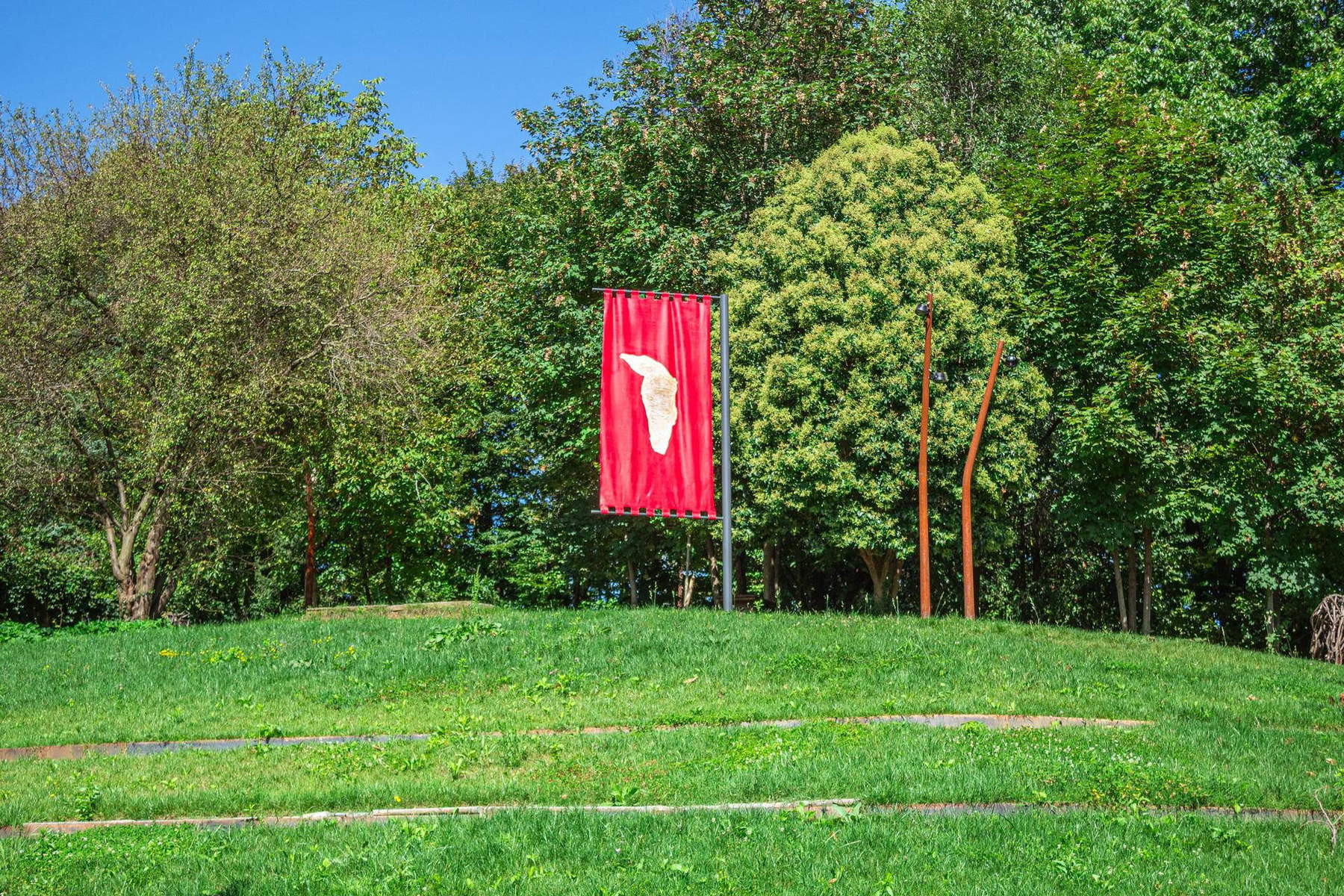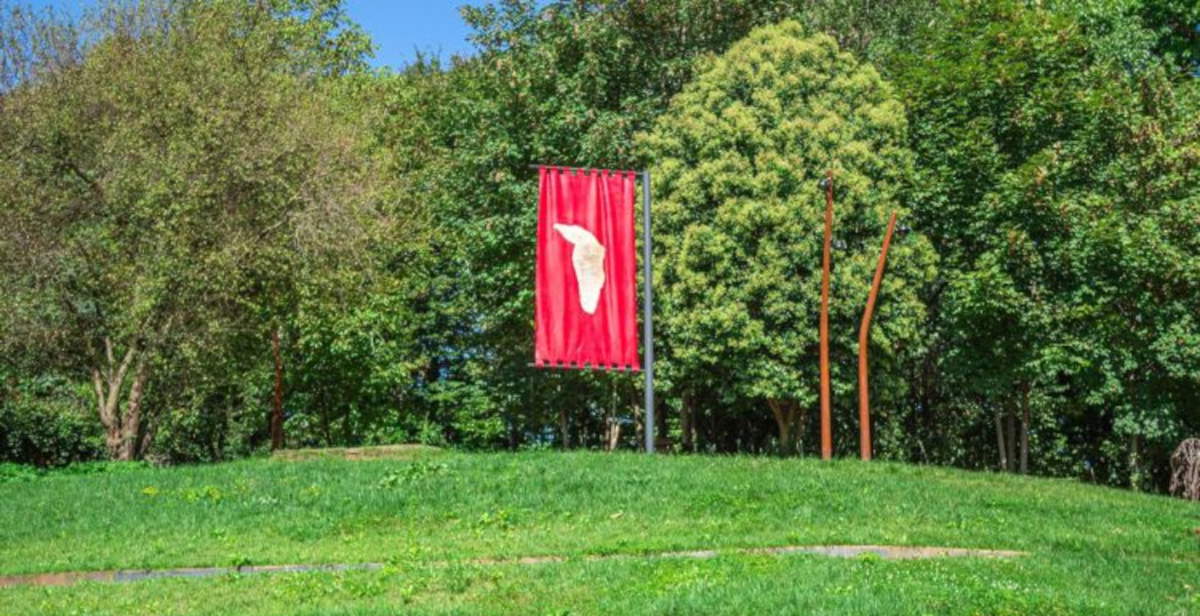Paolo Chiasera, an artist born in Bologna in 1978, inaugurated the Orti Tintori project, curated by Maria Luisa Pacelli and Elena Volpato, at the Accademia Carrara in Bergamo on Sept. 5, 2025, with a series of installations that unfold between the interior and exterior of the museum and dialogue with nature and the city’s artistic heritage. The exhibition will remain open until Jan. 6, 2026, and marks the start of the Carrara’s Art and Nature season, in conjunction with the Landscape Festival, an international event dedicated to landscape culture that has been active in Bergamo since 2011.
Inside the museum, the main installation, titled The Gardens of Sardinia, Cyprus, Jerusalem and Bergamo, consists of a large-scale oil painting that exceeds 26 meters in length. Chiasera has been setting up the work since 2014 in the different museums he comes into contact with, conceiving it as a mobile architecture capable of accommodating existing collections. The painted surface acts as a frame for selected works from the museum, including names such as Guercino, Andrea Fantoni, Carlo Antonio and Giulio Cesare Procaccini, transforming the painting into a device that integrates art and nature. The installation invites visitors to a complex experience: the plant and mineral elements that make up the pigments recall their natural origins, and through the strategic use of mirrors, the boundary between exhibition space and pictorial representation dissolves, making the ephemeral beauty of the gardens immortal on canvas. Chiasera’s choice to merge painting and museum architecture creates a kind of “theater of wonders,” where the visitor is welcomed as an active part of the work.
“We are delighted,” says Maria Luisa Pacelli director Fondazione Accademia Carrara and co-curator of the exhibition, “that the start of Accademia Carrara’s new season coincides with Landscape Festival, at a time when the museum, extending its programming to its own garden, is presenting a project for next fall focused on the relationship between art and nature, looking as much at tradition and its historical collections as at the present. Added to this is the happy coincidence of two artists, Sarah Price for Landscape Festival and Paolo Chiasera for Carrara, who for the creations made for the two events were inspired by the colors present in the museum’s works, thus enhancing its heritage from a new point of view full of potential.”
“The involvement of Paolo Chiasera and the collaboration with Landscaspe Festival,” Sergio Gandi councillor for Culture Municipality of Bergamo, "testify to Accademia Carrara’s commitment to creating ties with the territory, as well as a particular attention to themes that, starting from reflection on the past, actively involve our present. Carrara thus confirms itself as an institution attentive to the dynamics that traverse society, aware of how the strength of its civic role is nourished by contemporary languages and rhythms. The Museum and its Garden thus become increasingly inclusive and culturally rich places.

Outside, in the PwC Gardens, the recently redeveloped space that will be inaccessible until 2024, Chiasera proposes the installation Orto tintorio di Bergamo. Here the artist experiments with nature through the planting of two plants historically used for the production of pictorial pigments. Next to the plants, a small bronze buried and marked by two banners painted in oil on canvas indicates the point of sowing, while the pigments in the paintings are derived from the same cultivated essences. The work creates a direct link between art and nature, between the history of the painting materials and their plant origin, giving the gardens both an aesthetic and educational function. Free access to the space allows visitors to engage with the work in an everyday context, promoting an experience of contemplation that integrates culture, landscape and leisure.
Orti Tintori inaugurates a broader museum itinerary, the Art and Nature project, which includes exhibitions and educational activities in dialogue with the landscape and the historical collection. Autumn at Carrara will feature a series of events ranging from exhibitions dedicated to stone painting between the 16th and 17th centuries to the A&N KIDS initiative designed for younger audiences. Chiasera’s presence at the opening of the season confirms the museum’s focus on contemporary research and experimentation, in which the interaction between the work, space and nature becomes a central element.
“The intervention involves the growth in two sites of the Carrara gardens of dye plants related to the pigments used in the paintings in the Collection,” says artist Paolo Chiasera. “The species identified after a study of natural pigments related to the museum are Reseda Luteola and Rubia Tinctorum. From these plants we get arzica yellow and garanza lacquer, fundamental to Italian painting until the 1700s, but now replaced by similar chemicals. As an omen to future collecting for each site, a small bronze representing an ancient species of potato is interred, recalling the sacred female figurines from matriarchal times studied by Lithuanian archaeologist Maria Gjmbutas.”
“I find fascinating,” says Elena Volpatoco, curator of the exhibition, “in Chiasera’s project the interweaving of two attitudes traditionally at the antipodes: pictorial mimesis that feigns nature in the space of art - in the indoor room - and the presence of nature itself as a living, constituent component of the work - outdoors. The two interventions are in inverted dialogue, as in a game of mirrors.”
 |
| Paolo Chiasera brings nature to Bergamo's Carrara Academy with "Orti Tintori" |
Warning: the translation into English of the original Italian article was created using automatic tools. We undertake to review all articles, but we do not guarantee the total absence of inaccuracies in the translation due to the program. You can find the original by clicking on the ITA button. If you find any mistake,please contact us.